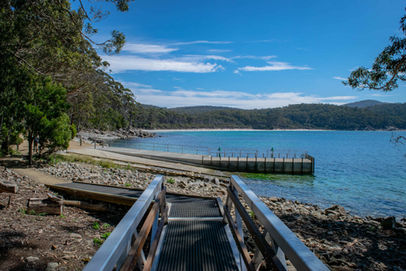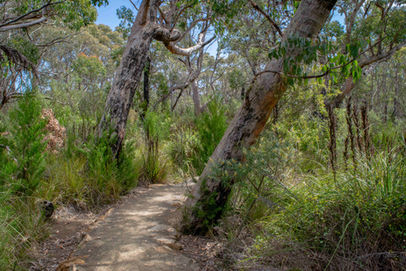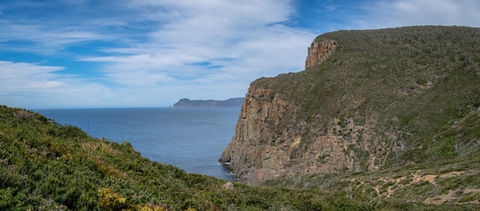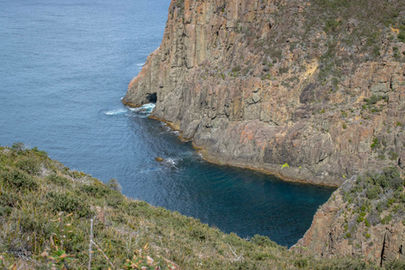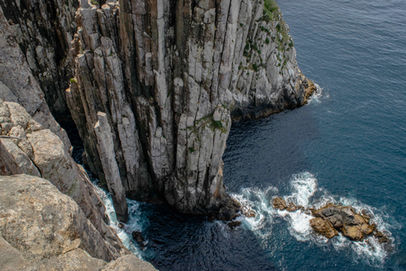
Cape Hauy Track
Tasman National Park
Start - Fortescue Bay
Trail Type - Hike
Length - 10.0km (Return)
Elevation - 466m
Time - 3-5 Hours
Date Hiked - 22nd October 2018
Directions - Located just over 90 minutes south east of Hobart, to reach Cape Hauy head east out of the city on the Tasman Highway and follow the signs for Port Arthur. Before the Port Arthur Lavender Farm turn left onto Joiners Link then right onto Coronation Road before a left onto Fortescue Road. Follow this all the way down to the car park at Fortescue Bay.
The Hike - With the Tasman National Park famous for the Three Capes Track and the great four day adventure that you can have on that experience, the good news for hikers looking for a day hike is that most of the park is still accessible. If you don't have the time, money or gear to do the Three Capes (or have just missed out on a booking) then you can still access both of the capes (yes the Three Capes only visits two of the capes). The day trip to Cape Pillar is the longer option at 18km so Cape Hauy at 10km return is a good length with plenty to see along the way. Day or weekend trips from Hobart exploring the historic Port Arthur region of the state wouldn't be complete without some time in nature and the Cape Hauy Track is a fantastic option if that's what you want to do.
Once you driven through the forest along the bumpy gravel roads and reached the car park, the beautiful Fortescue Bay is visible through the tree line. This picturesque turquoise bay is where the forest meets the water with a thin strip of white sand providing a fun border. The result is very photogenic and if you pick a sunny day then it almost feels like you're on a tropical beach somewhere in Mexico (minus the palm trees). There are campgrounds available if you want to make a weekend of it and you can't argue with the location. The start of the trail begins at the north eastern side of the car park and heads towards the boat ramp (follow the orange markers). With the money that has been poured into the Three Capes Track, you can certainly tell from the get go on this essentially almost free hike (Tassie Park Pass is required) that the track is going to be a good one. A metal bridge takes you over a small stream and you begin hiking along the edge of the bay and up the hill. Resting sea birds were making some noise on the rocks below as we passed but it isn't long before you lose touch with the shoreline as you get higher up the hill and into the dry sclerophyll forest that dominates the coastal parts of the Tasman Peninsula. With the views out over the bay keeping your eyes distracted, I enjoy that the trees compliment the view rather than get in the way.
Reaching the public art display that signifies the ceremonial end of the Three Capes for those completing the journey, it's a fun piece that overlooks Fortescue Bay and makes for a nice photo opportunity. Still continuing uphill you leave the views of Fortescue Bay behind and enter the thickest part of the forest for a mix of boardwalk and single track towards the Cape Hauy turnoff. This is a really relaxing part of the hike and it doesn't feel like you need to rush to get to the money shots of Cape Hauy. The thick tree trunks and lush undergrowth provide welcome relief if it's a warm day and a section of native pines adds a bit of variety to the mix. In spring and summer watch out for the wildflowers that blanket the undergrowth along with the occasional skink sunning itself on the boardwalk sections. At the 3.5km mark the forest starts to thin a little and you catch sight of the Cape Hauy turnoff. A rather elaborate meeting junction, depending on the time of day you might see a lot of backpacks stacked against the seats as Three Cape Track hikers dump their packs for the return trip out to the cape.
The 3km return journey from here is a very hilly affair that is best done with a day pack or no pack at all so you can enjoy the experience without thinking about hauling a heavy pack up and down the stairs. There isn't just one descent on the way to the viewing platform over Cape Hauy but a series of hills that really takes it out of you if you aren't prepared. A lot of the 466m vertical distance is covered here but for the beginning section you descend down the steep stairs. You can see the trail snake its way towards Cape Hauy in the distance and it looks a bit daunting if you're a casual hiker. At the bottom of the hill you get some impressive views looking back up to the trail junction and further in the distance and to the left is Mount Fortescue, a temperate rainforest delight. Here you are close to a small bay to your right and it's a really cool opportunity to see the dolerite cliffs a little bit closer (please stay on track though). These impressive geological features are what makes the Tasman Peninsula so unique and gives a very striking appearance to the surrounding cliffs. As you climb up the first of a couple of hills the views keep getting better as more of the landscape opens up before your eyes. At the top you can see Cape Pillar and the Munro Bight to the south and the entry to Fortescue Bay is once again visible. As you dip down into another little valley you can see the edges of a sinkhole to the left that looks like the cape has been deeply scarred and disfigured. As you rise up and get closer to the lookout things become a little narrower and you get a sense of high up you are on the cliffs.
There are several spots where you get right on the edges of the cliffs to the east for a peak at the drop off down to the ocean. The views here are the best as you are a good distance from the trail junction so can see all the way from Cape Pillar around the expanses of the Southern Ocean and back towards the northern borders of the national park. A final series of steep steps leading up and down the rocky terrain is all that stands between you and the lookout platform at the edge of the track. With epic views of the eastern tip of Cape Hauy along with leg shaking views down (if you don't like heights) towards the dolerite pillars rising out of the ocean. The famous pillar here is the Totem Pole, the dolerite column standing on its own to the left as you look down at the water below. Rock climbers make their way along the cape and climb down to the cliffs next to the Totem Pole before swinging ropes over to it, where they proceed to make their way over and climb up and down. Brave stuff but a big no thanks from me. With plenty to take in from this lookout you could spend a lot of time just admiring the rugged beauty of this part of the Tasman Peninsula before turning back and hiking the 5km back to the calmer waters of Fortescue Bay, where you can enjoy a dip in the chilly waters to cool off.
Final Thoughts - A very popular day hike in the Port Arthur region along with the Cape Raoul Track, it's easy to see why with such a rugged yet beautiful landscape to explore.
Starting in the stunning Fortescue Bay, hiking through some lovely old forest before experiencing the dramatic landscape and epic views of Cape Hauy has to make this one of the best day hikes in the state.
At 10km it is a good distance for those wanting to stretch their legs and the vertical climb will provide a great leg workout.
While there is some outrage in the hiking community about exclusive use tracks for those who pay for the experience, I think that the Tasman Peninsula is an example of how you can do this correctly.
The major wow moments of the national park are still accessible to day hikers that don't want to fork out for the $550, four day experience and with a free campsite at Wughalee Falls, you can even enjoy an overnight trip.
If you're in the area then make time to hike this one, you won't regret it.
Get out there and experience it!
Be sure to tag any Cape Hauy Track photos on Instagram with #thelifeofpy and if you enjoyed this hike then feel free to share this page on Facebook with your friends.
If you've found this page or the website helpful and you want to show your support then consider making a small donation by visiting our Ko-fi page. You can give as little as a dollar with no sign-up required and everything will be put towards the website, creating new content and promoting the trail community.









